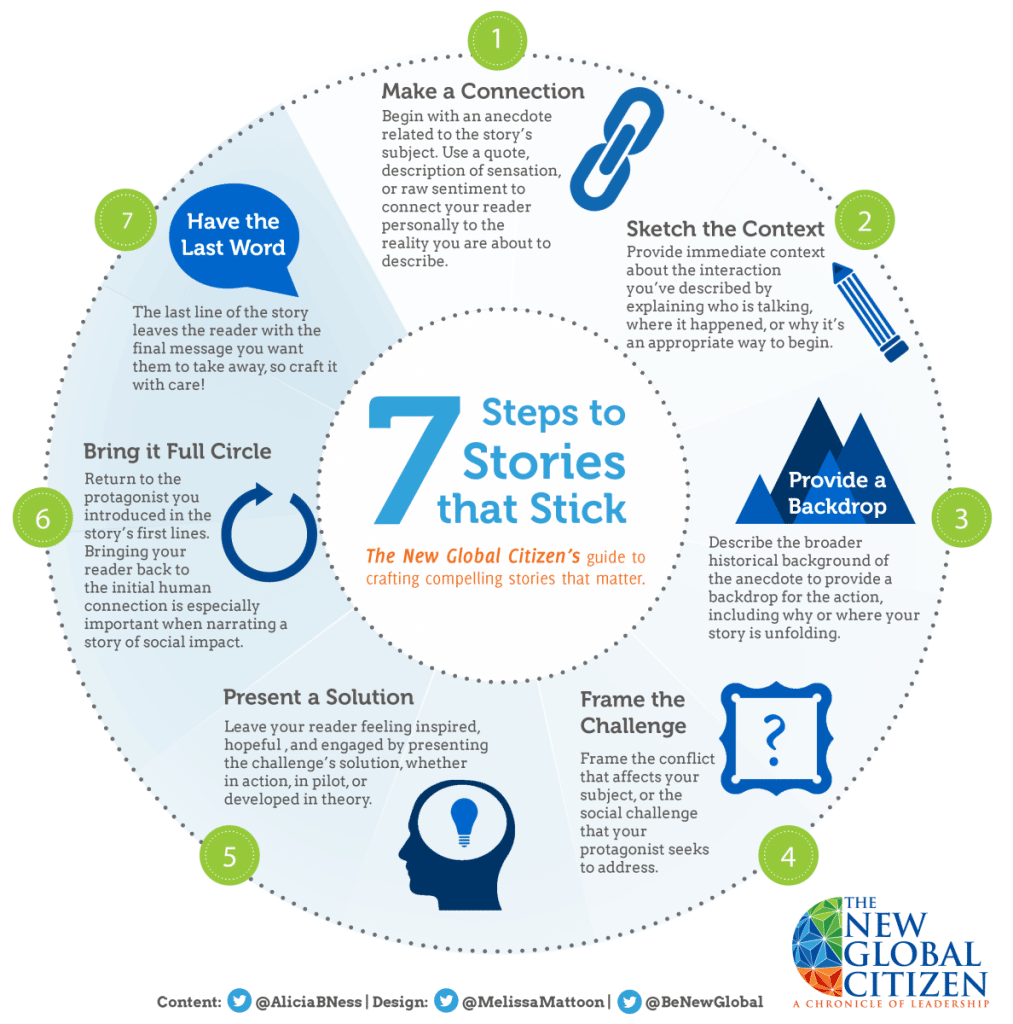Most individuals and organizations doing work in global engagement have a story to tell, a story that is important, inspiring, and impactful. It’s a story that needs to be told.
In 2013, the world of social impact was alive with one word: storytelling. Everyone was talking about how compelling stories could transform how organizations communicate. Stories are powerful tools that can explain the impact of an approach to problem-solving. They also animate the people and personalities doing great work and appeal to emotions that will motivate others.
Ultimately, good storytelling brings good work to life. But good stories are harder to tell than you might think. As the Editor of The New Global Citizen, I’m frequently asked, where do I start? How do I tell a story that matters? As other Editors have done in the past, I’ve compiled an explanation of how we at The New Global Citizen work to craft compelling stories.
Every good story has narrative structure, which requires a setup, conflict, and resolution. Here are the seven easy steps to tell your story in a way that is compelling and meaningful.
1. Start Personal, Make a Connection
The setup for a good story almost always begins with an anecdote or a personal interaction related to the story’s subject. Sometimes this is the description of sensation or a provocative quote. Other times it is the narrated setting of your story’s protagonist. And sometimes it’s just raw sentiment, as when PYXERA Global CEO Deirdre White opened her though-provoking piece on the Hult Prize Challenge winner’s food security solution with one word: “Eeeewww.” Starting personal places your reader in the shoes of the subject or the author, to make it possible for them to imagine the reality you are trying to narrate or explain. It’s important to “hook” the reader and draw them into the story.
2. Sketch the Context
Once you begin a story with an anecdote, you have to provide your reader with immediate context about where or why the interaction took place. This can mean explaining who is talking, where it happened, or as in the case of the Hult Prize Challenge piece, why it’s an appropriate way to begin. Sketching the context around the interaction, rather than around the subject of the piece as a whole, once again helps bring the reader along into your experience.
3. Provide a Backdrop
Once you’ve provided immediate context for the action taking place among the players in your story, it is important to turn to the broader historical background that provides a backdrop to the action. Such background should address where and why you or your subject is doing what it is doing. This can be anywhere from one to five paragraphs, depending on the complexity of the point you are trying to make or the narrative you are attempting to weave.
4. Frame the Problem or Challenge
Next, turn to your story’s conflict. This can be a problem that specifically affects your story’s subject, or a pernicious global (or regional) challenge that your protagonist seeks to address. Provide as much detail as you can about the challenge and its origins without turning your story into an academic missive on the subject. This is often a difficult balance—be sure to focus on the key details that are relevant to your thesis and the point your story is trying to reinforce. This is often at least two paragraphs, but try to avoid going beyond four.
5. Present a Solution
Simply initiating a story’s conflict isn’t enough—your reader needs resolution. To leave your reader feeling inspired and hopeful, you have to present the problem’s solution, whether it is in action, in pilot, or simply developed in theory. At the highest level, your explanation of the solution should chart the hypothetical or planned course ahead to address the problems you have presented. By outlining potential solutions to the challenges you have introduced, you also create the opportunity to keep your reader engaged—they will want to hear about what will happen next.
6. Bring it Full Circle
The (not so) secret sauce to a goosebump-worthy story is returning to the protagonist you introduced in your story’s first lines. What role did those individuals play in executing the solution? How will its achievement affect their lives? Bringing your reader back to the initial human connection is especially important when narrating a story of social impact.
In every section of the setup, conflict, and resolution, I encourage writers to adopt a tone of ‘analytical storytelling,’ capturing the granular details of the action taking place while adding an inquisitive and analytical perspective. Some authors intentionally avoid the first person, but sometimes speaking for yourself is the most effective way to relay your personal perspective. Use the narrative tone that feels right for the subject. Readability matters more than anything. Use the Flesch-Kincaid reading ease tests, available in Microsoft Word, to test your story’s readability and meet your readers where they are.
7. Don’t Forget to Have the Last Word
Content on the internet is growing at an exponential rate and many writers are attuned to the fact that most internet readers are fickle at best—fewer than half those who see a story will get half of the way through it. Yet, the last line of your story is still very important, especially if it will ever appear in print. While people reading on the web often get distracted by other links, stories, or online activities, print readers are more committed. Just like the P.S. in direct mail, the last line of your story leaves your reader with the final conclusion you want them to take away from your piece, so craft it with care!
Now it’s your turn to tell a story of impact. Submit your piece or proposal to The New Global Citizen here.
________
7 Steps to Stories That Stick by The New Global Citizen is licensed under a Creative Commons Attribution-NoDerivatives 4.0 International License.
Feature photo: KennyMatic BY CC 2.0
Alicia Bonner Ness
Alicia Bonner Ness (@AliciaBNess) is the editor of the The New Global Citizen, where she seeks to showcase the impact of beneficiaries and implementers alike, empowering all those engaged in furthering social good to learn from one another. She is also the Communications Manager at PYXERA Global.








Many good ideas and lots of sound advice. What concerns me is that this makes it appear that all you have to do is follow the steps in a prescribed sequence and you will have a good story. But just as painting by numbers sets as a child never turned me into a great artist, following your storytelling by numbers approach will not turn people into great storytellers.